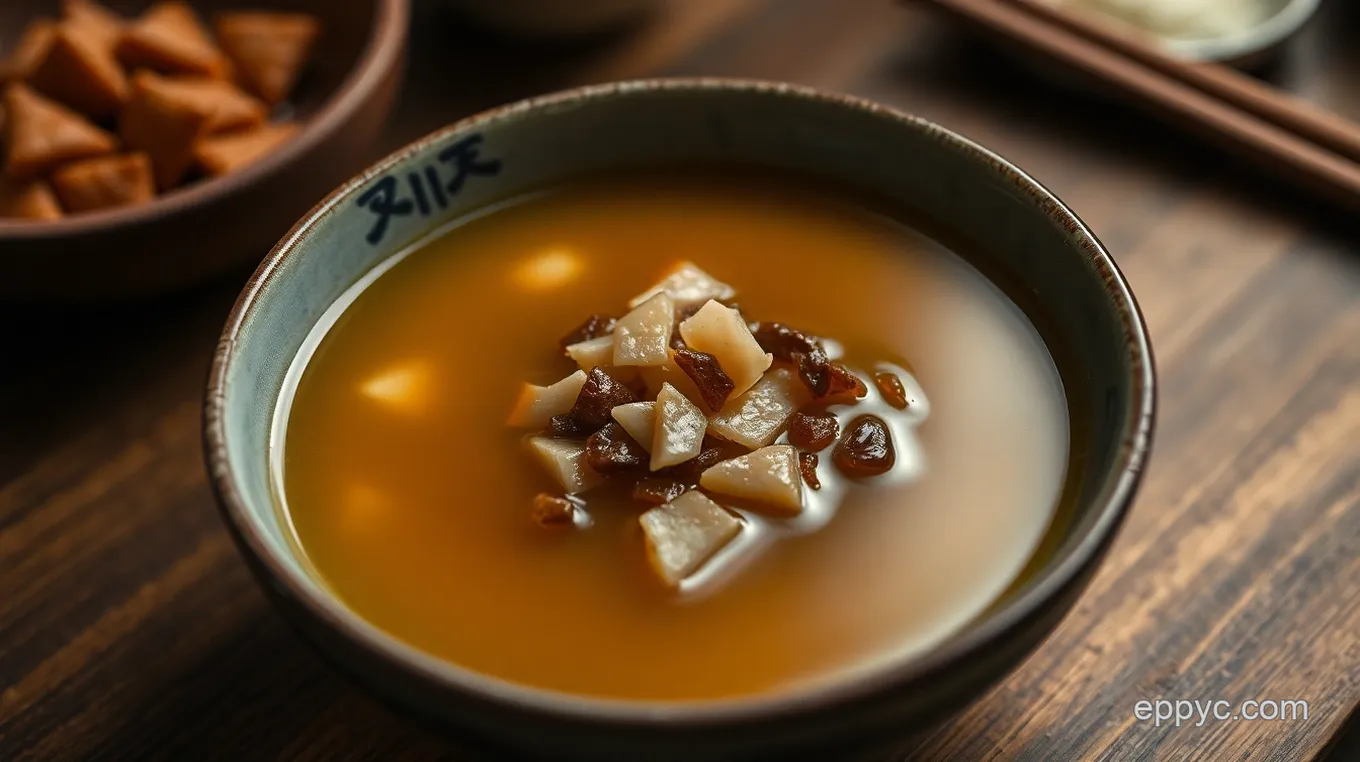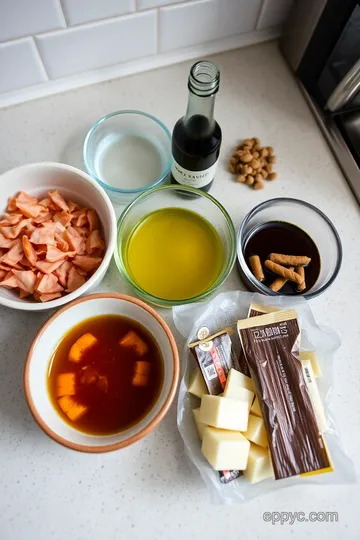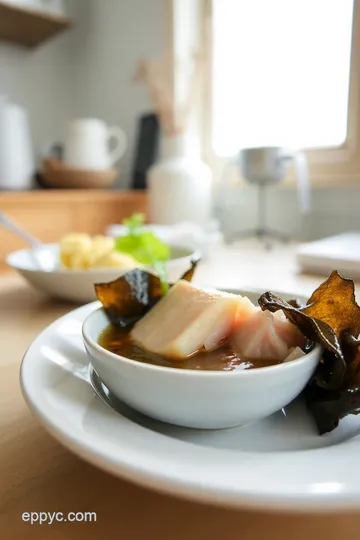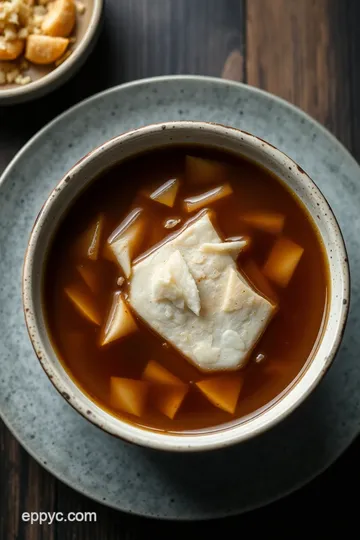Umami Awaits: Authentic Shirodashi Broth
Discover the perfect shirodashi recipe! My easy guide delivers a light, umami-rich broth to elevate your Japanese dishes. Let's cook together!

Have you ever had a bowl of soup that just made you go, “wow!”? you know, that moment when you taste something so good, it feels like a warm hug from the inside? for me, that first spoonful happened when i discovered shirodashi .
This light, delicate broth isn’t just any broth. it’s a beautiful blend of flavors that dips its toes into the world of japanese cuisine and brings that umami goodness right to your table.
Honestly, once you taste it, you'll be obsessed!
In my journey of cooking, i realized shirodashi isn’t just a broth; it’s a connection to tradition. originating from the heart of japan, shirodashi is a spinoff of the classic dashi, made primarily with katsuobushi (those yummy bonito flakes) and kombu (kelp).
It’s like a backstage pass to making your meals pop! with its roots in authentic japanese cooking , it's become a staple for many home chefs looking to jazz up their dishes.
And believe it or not, it's super easy to make!
Recipe Overview
Let’s get into the nitty-gritty. shirodashi dates back to centuries ago when japanese families would gather to enjoy meals prepared with love and tradition.
Fast forward to today, it's become a go-to broth for japanese dishes like ramen, udon, or just about any broth-based soup idea you can dream up.
Worried about time? don’t be! this recipe takes just 40 minutes and it’s rated easy . trust me, the hardest part will be waiting for the flavors to come together.
Plus, it yields about 4 cups , so you’ll have plenty of broth to play with in your recipes or just slurp down on its own.
And let’s talk cost. making shirodashi won’t break the bank. with just a few simple ingredients, you can whip up a batch that’s both wallet-friendly and bursting with flavor.
You might already have some of the stuff hanging out in your pantry.
Key Benefits
Now, let’s dive into the benefits of shirodashi. first off, it's a low-sodium broth option when you choose light soy sauce.
No weird preservatives or things you can’t pronounce—just good, simple ingredients! plus, the health benefits of dashi are huge. kombu adds essential minerals while bonito offers a punch of protein, making it a nourishing choice for your family.
What’s better? shirodashi is so versatile. use it as a base for flavorful soba noodle recipes , in saucy stir-fries, or even as a cooking liquid for rice.
You can even kick it up a notch and add in seasonal veggies for some extra flair. it’s perfect for special occasions or just a cozy night in.
And let’s not forget, it's simple. you don’t need to be a culinary genius to make this broth. with a few easy techniques like simmering and straining, you'll feel like a pro in your own kitchen.
I still remember my first attempt—before i realized the magic of using shirodashi in cooking . it transformed my humble ramen into a delightful experience, one that made me think, “i can actually cook!”
So, ready to get your hands a little messy? Let’s dive into the ingredients and start crafting this fabulous broth that’ll bring that umami flair into your everyday meals!

Essential Ingredients Guide
Alright, folks! let’s dive into the world of cooking, focusing on the essential ingredients that can transform your dishes from ordinary to extraordinary.
Trust me; you don’t wanna miss this because having the right tools and components is half the battle, especially when it comes to creating japanese broth recipes like shirodashi!
Premium Core Components
First, let’s talk measurements because, you know, cooking can be a bit messy if you don’t get this right! Here's the deal:
-
Dried bonito flakes (katsuobushi) : 1 cup (that’s about 75 grams). Always check for high-quality flakes; they should smell like the ocean, not like fish gone bad!
-
Light soy sauce : 1/4 cup (60ml). For those of you watching your sodium, low-sodium soy sauce works just fine.
-
Kombu (dried kelp) : 1/4 cup (about 20 grams). Look for shiny pieces; dull ones have lost their oomph.
Now, let’s chat about storage and shelf life . keep these goodies in a cool, dry place. use them within a year for the best flavor—seriously, no one wants old flakes in their dashi! if you’re eyeing kombu, it can last way longer, but check it before you toss it in your pot.
For freshness, take a sniff! If it smells like your high school gym socks, it’s time to toss it. Always keep an eye on the expiration dates.
Signature Seasoning Blend
Now, let’s get into those essential spices . You can’t have umami-rich broth without a combo of flavors! Think about how you can enhance your dishes with:
-
Garlic and ginger : These bad boys can wake up your broth, making your broth-based soup ideas pop.
-
Seaweed : Besides kombu, don’t forget about nori for garnish. It adds a little flair!
-
Herbs : Fresh cilantro and green onions are great last-minute additions—trust me, it’s a game-changer for those flavor profiles!
When you stir all these flavors together with shirodashi, your soup is going to sing! you can also explore some regional variations .
Maybe play around with some chili flakes if you want a kick, or even add lemongrass for a fusion flavor.
Smart Substitutions
Sometimes life gets in the way, and you find yourself missing an ingredient. No sweat! Here are some common substitutions :
- No soy sauce? Try tamari for gluten-free goodness.
- No mirin? A splash of honey mixed with water will do in a pinch.
- If you run out of bonito flakes, give shiitake mushrooms a whirl for a vegetarian option.
These simple tweaks mean you can still create delicious, umami-rich broth without trekking to the market. Don't be afraid to experiment—sometimes you’ll discover something fantastic!
Kitchen Equipment Essentials
Let’s not forget the tools! Here’s a quick list of must-have tools for your broth adventures:
-
Medium saucepan : Your go-to for simmering. Make sure it has a lid.
-
Fine mesh strainer or cheesecloth : Perfect for separating those flavorful bonito flakes from your broth.
-
Wooden spoon or whisk : Essential for stirring (and it’s less noisy than metal!).
If you’re feeling fancy, consider a countertop strainer for easy pouring, or you can even use a coffee filter if you're in a pinch—trust me, I’ve done it!
Cooking with Dashi
Alright, now that we’ve covered all the essentials, it’s time to get cooking! You’ll have your broth simmering in no time.
Remember, using shirodashi in cooking opens up a treasure trove of flavor possibilities. this broth isn’t just for soup; it’s also amazing for steaming veggies, cooking rice, or even as a base for fusion recipes ! seriously, if you haven’t tried it, you’re missing out.
So gather your ingredients, spice it up with some personalized flair, and let’s get started on making your very own shirodashi! the journey is just beginning, and i promise you’re gonna love every flavorful moment of it.
Get ready for some cooking magic!

Unraveling the Secrets: Professional Cooking Method
If you’ve ever watched a cooking show, you know that professional chefs make it all seem so effortless, right? but trust me, it takes more than flair to whip up something delicious.
It’s all about mastering some key professional cooking methods . let’s dive into prep—because nothing spells disaster like starting to cook while you’re still frantically chopping vegetables!
Essential Preparation Steps
First off, let’s talk mise en place . this fancy term just means having everything ready before you cook. get your ingredients sliced, diced, and laid out.
Not only does this make your cooking smoother, but it also makes you feel like a pro! by the way, having things ready helps you manage your time.
Time management tips ? set a timer when your dish requires specific cooking times. it’s like your little buddy reminding you to check on that pot of shirodashi boiling away!
Speaking of organization, i’ve got a little gem for you. keep your workspace clean and tidy. clutter can add to stress, and we don’t want any accidents, especially with hot broth.
And let's be real—they happen. so, safety considerations are essential. always have a fire extinguisher handy and make sure wet hands don’t reach for sharp objects.
You don’t need a trip to the emergency room to remind you of that!
Step-by-Step Process
Alright, so let’s break it down. Here’s a clear list to follow, no fluff, just good cooking.
-
Gather Your Ingredients : For our shirodashi, you’ll need dried bonito flakes, light soy sauce, water, dried kombu, and mirin.
-
Prepare the Kombu : Rinse it off and soak it in 2 cups of water for about 10 minutes .
-
Heat it up : gradually warm your kombu-infused water over medium heat. when you see little bubbles forming but it hasn’t reached a boil— turn off the heat and fish out the kombu.
-
Add Bonito Flakes : Toss in 1 cup of bonito flakes and let it simmer for about 5- 7 minutes . This is where the magic happens!
-
Strain the Broth : After simmering, strain that liquid gold through a fine mesh strainer. It should have a light, beautiful color.
-
Seasoning Time : Stir in your light soy sauce and mirin. Remember to taste it; seasoning is key.
-
Cool and Store : Let it cool, and you’re good to go! Shirodashi keeps well in the fridge for about a week.
Expert Techniques
Now, if you want pro-level broth, here are some critical steps . pay attention to the water temperature when you're simmering.
Too hot, and you risk bitterness. for a richer flavor, consider doubling the 1 cup of bonito flakes . remember, it's all about balancing flavors.
Quality checkpoints are critical—don’t settle for subpar ingredients. use high-quality bonito flakes and kombu. trust me, your broth will thank you! if it’s not up to snuff, you can troubleshoot.
Too salty? add a bit of water. not flavorful enough? add a dash of soy sauce.
Success Strategies
Let’s face it: common mistakes happen when cooking. overcooking your bonito flakes turns your shirodashi a bit cloudy and bitter.
To avoid this, don’t go rogue and crank up the heat too high! it’s all about maintaining the right temperature.
For quality assurance tips , always taste your broth before you declare it done. if it’s lackluster, think about adding some mushrooms or herbs.
Oh, and if you’re planning ahead, make-ahead options are plentiful. you can prep and freeze portions of shirodashi for quick meals later!
Wrapping it Up
So there you have it! mastering the art of cooking, especially creating that beautiful, umami-rich shirodashi, is all about preparation, patience, and practice.
Whether you use it in a comforting noodles bowl or as a base for your broth-based soup ideas , you’ll feel like a rock star in the kitchen! next up, we’ll dive more into some additional information regarding variations and how to elevate your favorite broths.
Your cooking will never be the same again!

Pro Tips & Secrets to Mastering Shirodashi
Let’s be real here – making shirodashi broth is super simple, but there are some golden rules that'll level up your broth game.
First off, always use quality ingredients . seriously, good bonito flakes (that’s your katsuobushi ) and kombu can make or break your broth.
Ain't nobody got time for bland; we want umami-packed magic, right?
Next, timing is everything. when you simmer the broth, it’s crucial to avoid boiling. just get it to a gentle simmer.
If you boil, you can bring out bitterness from the bonito flakes. who wants that? trust me on this one; keep the heat steady and low, and you'll savor that delicate flavor.
Now, if you're in a pinch, there are also dashi alternatives out there. you can find various products that mimic the flavor, but they might lack that authentic touch.
If you're interested in experimenting, consider making a vegetarian shirodashi recipe , using dried shiitake mushrooms instead of bonito flakes – it gets the umami vibes going too!
Perfect Presentation
Okay, let’s talk about making your shirodashi look as good as it tastes. plating is key here! when you’re serving a broth-based dish like soba noodles, use a wide bowl .
Start with your noodles, then ladle that beautiful shirodashi over. garnish is your best friend! think green – chopped chives or a sprinkle of sesame seeds can elevate your dish visually.
Color combos make a difference too. you want that bright contrast! feel free to toss in colorful veggies like sliced radishes or edamame if you're going the additional mile.
Presentation isn’t just for restaurants, my friend; it can make a simple home-cooked meal feel like a special occasion!
Storage & Make-Ahead
Here’s a pro tip: shirodashi keeps well! if you’ve made a big batch but can’t use it all at once, don’t worry.
Cool it down, cover it up, and it’ll chill in the fridge for about a week. just remember to store in a sealed container .
If you want to stretch its life a bit more, you can freeze it in ice cube trays and pop out just what you need later.
How cool is that?
When reheating, do so gently! You don’t want to bring it back to a boil. Just warm it over low heat, and you’ll be good to go!
Creative Variations
Get ready to mix things up! you can play around with flavors in so many ways. for a kick, add some slices of fresh ginger while you’re simmering.
Feeling adventurous? try herbal shirodashi with dried mushrooms for that earthy depth.
And don’t shy away from seasonal ingredients! when summer rolls in, swap out heavier vegetables for lighter, fresher ones. if you’re feeling health-conscious, consider low-sodium broth options by going easy on the soy sauce while still maintaining that delicious flavor.
Complete Nutrition Guide
Now, let’s break down the goodness in shirodashi! a cup packs about 20 calories, which is pretty light if you ask me! plus, you’re getting some protein from the bonito flakes, making it a great base for a nutritious meal.
If you're mindful of sodium, don’t hesitate to go for low-sodium soy sauce – your heart will thank you, and you won’t lose that umami vibe.
Using shirodashi in cooking opens up a world of benefits. it’s not just a soup base; think rice, sauces, and even marinades! infusing your dishes with shirodashi can lead to flavorful results without piling on calories.
To Wrap it Up
So, next time you’re in the kitchen, remember that making authentic japanese cooking with shirodashi isn’t just for the pros.
It’s for everyone who wants to dabble in deliciousness! whether you serve it straight, use it for noodle dishes, or play around with variations, this broth adds that special umami touch that can brighten up any meal.
Cooking should be fun and enjoyable. So, get in that kitchen, experiment with flavors, and don’t be afraid to make it your own. You got this! Happy cooking!
Frequently Asked Questions
What exactly is shirodashi and how is it different from regular dashi?
Shirodashi is a type of Japanese broth that is lighter in color and flavor compared to regular dashi, which is typically darker. It is primarily made from dried bonito flakes (katsuobushi) and kombu (kelp), creating a delicate umami base that enhances the flavors of other dishes without overpowering them.
Can I make shirodashi vegetarian or vegan?
Yes, you can easily create a vegetarian or vegan version of shirodashi by replacing the bonito flakes with dried shiitake mushrooms. This substitution will provide a delightful umami flavor while keeping the broth plant-based.
How should I store leftover shirodashi?
Leftover shirodashi can be stored in an airtight container in the refrigerator for up to a week. If you want to keep it longer, consider freezing it in ice cube trays for easy portioning later.
What are some good ways to use shirodashi in cooking?
Shirodashi is incredibly versatile and can be used as a base for miso soup, noodle bowls, or even as a cooking liquid for grains. Its delicate flavor pairs well with light proteins and seasonal vegetables.
Can shirodashi be used in place of regular broth in recipes?
Absolutely! Shirodashi can be used in place of regular broth in many recipes. Just keep in mind that its flavor is more subtle, so you may want to adjust the seasoning accordingly to get the desired taste.
What tips can you share for making the perfect shirodashi?
To make the perfect shirodashi, use high-quality bonito flakes and kombu for the best flavor. Avoid boiling the broth, as this can make it bitter; simmer gently for optimal results. Feel free to experiment by adding ingredients like fresh ginger or dried mushrooms for additional depth of flavor!
Umami Awaits: Authentic Shirodashi Broth Card

⚖️ Ingredients:
- 1 cup (75g) dried bonito flakes (katsuobushi)
- 1/4 cup (60ml) light soy sauce or low-sodium soy sauce
- 2 cups (480ml) water
- 1 tablespoon (15ml) mirin (optional)
- 1/4 cup (20g) dried kombu (kelp), cut into pieces
🥄 Instructions:
- Step 1: Rinse the kombu under cold water to remove any grit or impurities.
- Step 2: In a medium saucepan, combine the water and kombu. Let it soak for about 10 minutes.
- Step 3: Gradually heat the saucepan over medium heat until just before boiling. Remove the kombu and discard.
- Step 4: Add dried bonito flakes to the water. Simmer gently for 5-7 minutes.
- Step 5: Remove from heat and let sit for a couple of minutes. Strain the broth through a fine mesh strainer or cheesecloth.
- Step 6: Stir in the soy sauce and mirin (if using). Taste and adjust seasoning.
- Step 7: Let the shirodashi cool before using or storing in the refrigerator.
Previous Recipe: Chill Out: My Easy Aroma Joe’s Inspired Iced Coffee Recipe
Next Recipe: Easy & Flavorful snacks made on sticks nyt: Savory Chicken & Veggie Skewers
